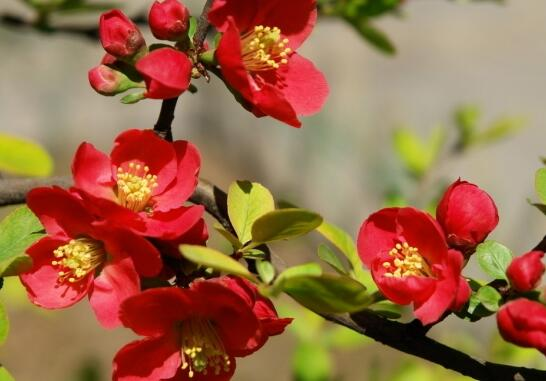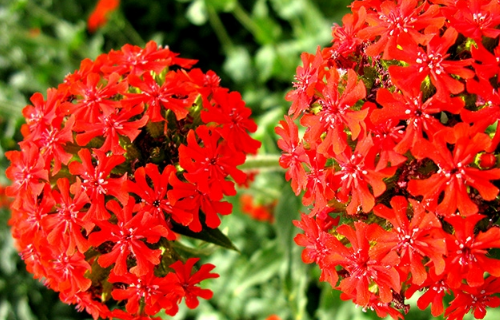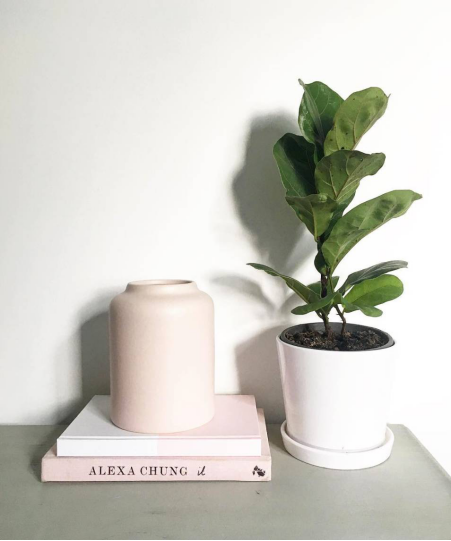Culture method of Tripterygium
First, the temperature should be suitable
Tripterygium is a kind of warm and adaptable plant. The most suitable temperature for the survival of Tripterygium is 15-28 ℃. At the same time, if the temperature is lower than-20 ℃, buried protection is needed to spend the winter.
Second, maintain humidity
Tripterygium is drought-resistant, so it doesn't need to be watered frequently. As long as keep the soil moist, and need to pay attention to timely drainage, there can be no stagnant water.
Third, the light should be sufficient.
Sticking Begonia likes sunshine and is suitable for places with plenty of sunshine and good air fluidity, but it should also be properly shaded in a hot environment in midsummer.
Fourth, fertilization should not be excessive.
Appropriate amount of fertilizer should also be applied, and liquid fertilizer should be applied 4 times a year to the flowering crabapple. And if you apply more phosphate fertilizer before flowering, you can make the flower color more gorgeous.
5. Pruning in time
The pruning of Tripterygium is generally pruned after flowering, and the flower branches of Tripterygium are moderately cut short, so as to promote the formation of flower buds and branches and increase the number of flowering.

Now that you have learned the daily culture methods of Tripterygium, let's take a look at how to reproduce.
The breeding method of Tripterygium
Tripterygium is a deciduous shrub with a plant height of up to 2 meters. It is a unique ornamental tree in China, which can watch both flowers and fruits. Today, we are going to share with you the culture methods and breeding methods of Begonia.
The culture method of Tripterygium
1. Soil: Begonia is not strict on soil quality, either slightly acidic soil or neutral soil, but it is better to use loose, fertile and well-drained rotten leaf soil or pastoral soil.
2, watering: stick stem begonia usually keep the basin soil moist, but must pay attention to prevent stagnant water in the basin, otherwise the root is easy to rot. The potted soil should not be too dry during the growing period of spring and summer, especially during flowering.
3. Sunshine: the bonsai of Begonia should be placed in a place with sufficient light and ventilation. When it is hot in summer, it is necessary to take proper shade to prevent the leaves from burning.
4. Temperature: sticking begonia is more cold-resistant in winter, and it is not strict with the environment. It can be buried in the soil or put into the indoor window.
5. Fertilization: sticking begonia should apply sufficient base fertilizer in winter, and dry cake fertilizer or rotten barnyard manure and bone meal are the best. During the growth period, thin fertilizer and water are often applied except for the rainy season.
6. Insect pests: sticking begonia often has rust on its leaves, which can be controlled by spraying Baume 0.5 degree stone sulfur mixture. The main insect pests are aphids, spider moths, red spiders and so on. The method of prevention and control is the same as that of Begonia.
7. Pruning: pedicled begonia is mostly carried out after flowering, and the branches that have flowered are generally cut short to promote the formation of branches and flower buds and increase the number of flowers in the coming year.
Propagation methods of Tripterygium
1. Sowing and propagation of Tripterygium
The main purpose of sowing and propagation of Tripterygium is to obtain a large number of neat seedlings, but it is not conducive to maintain the original good characters. This method is not suitable for potted plants with high ornamental requirements.
2. Branch propagation of Begonia affixed to the stem.
The tillering ability of Tripterygium is strong, so it is suitable for ramet propagation in early spring. The specific operation is to dig out the whole plant and divide it into 2-4 branches each with roots at the base. Cut off the split branches at the neck, leaving the rest about 10 cm short. Planted in a pre-prepared seedbed, strengthen management, after 1-2 years can be out of the nursery.
3. Cuttage propagation of Tripterygium
Cutting propagation of Tripterygium is usually carried out in summer. Sturdy new branches are selected, cut into cuttings 12-15 cm long, and inserted into substrates such as river sand or vermiculite. After cutting, it should be maintained in a hidden place for a period of time, during which the soil should be kept moist and it will take root in about 40 days.
After rooting, it is necessary to reduce water spraying and gradually prolong the light time, and finally remove the shade shed. In cold places in winter, open-field cutting seedlings need to cover grass or take other cold prevention measures to protect overwintering. The following spring transplant. Cuttings cut in pure sand or vermiculite should be transplanted in time after rooting, otherwise the new roots grow too long and the cuttings lack nutrition for a long time, which is disadvantageous to transplanting and growth.
More information on propagation methods of Tripterygium
Tapestry is a deciduous shrub of Rosaceae, and it is also a unique ornamental tree planted alone. What is the breeding method of sticking Begonia? Paste stem begonia how to breed? Next, let's take a look at the relevant information about sticking Begonia together with the editor.
Introduction of Tripterygium
Paste stem begonia alias: papaya, Prunus, wrinkled papaya, paste stem papaya, iron foot pear, wrinkled skin papaya, soup papaya, paste stem begonia, Xuan papaya, etc., Latin name: Chaenomeles speciosa (Sweet) Nakai, Rosaceae, papaya belongs to deciduous shrubs. Belongs to the rose family plant, the fruit is human medicine, has the function of relaxing muscles and activating collaterals and dissolving dampness in the stomach. Changyang "Ziqiu wrinkled papaya" recorded in Chinese Pharmacopoeia is a kind of wild medicinal papaya, which has unique medicinal and health care value, and has the reputation of "the fruit of a hundred benefits". Wrinkled papaya is also a unique ornamental tree planted alone. The branches are dense and spiny and can be used as green Gracilaria. The fruit contains malic acid, tartaric acid, structural citric acid and C vitamins, which can drive away Phoenix, relax muscles, activate collaterals, relieve pain, detumescence and smooth qi.
1. Morphological characteristics
Shape: pedicel begonia deciduous shrub, up to 2 meters high, with spines; branchlets cylindrical, spreading, stout, purplish brown when young, glabrous, dark brown when old.
Leaves: leaf blade ovate to elliptic, sparsely long elliptic, 3-10 cm long and 1.5-5 cm wide, apex acute, sparsely rounded-obtuse, base cuneate to broadly cuneate, margin acutely serrulate, tooth tip spreading, surface glossy, dark green, glabrous, abaxially light green, glabrous; petiole 1-1.5 cm long, glabrous; stipules large, leaflike, ovate or reniform, margin acutely doubly serrate, glabrous.
Flowers: flowers 2-6 clumps on biennial branches, 3.5-5 cm in diameter, blooming in front of or at the same time as leaves; pedicel thick and short, 3 mm long or nearly sessile, glabrous; calyx tube outside glabrous; calyx lobes erect, subsemicircular, apex obtuse, entire or undulate teeth, margin yellowish brown eyelashes, glabrous outside, sparsely pilose inside, half of calyx tube. Petals suborbicular or Obovate, shortly clawed, 1-1.5 cm long, scarlet or reddish; stamens 35-50, erect, 1-1.3 cm long, filaments slightly reddish; style connate below middle, glabrous, nearly as long as stamens, stigma capitate.
The flowering period of Tripterygium is from March to April.
Fruit: pear fruit of appressed begonia globose to ovate, 3-5 cm in diameter, yellow or yellowish green, with inconspicuous sparse spots, aromatic, pedicel short or nearly absent.
Paste stem begonia fruit period in October.
2. Ecological habits
Stick stem begonia like light, more cold-resistant, not resistant to flooding, do not choose soil, but like fertile, deep, well-drained soil. Tripterygium is a deciduous shrub of Rosaceae and papaya, up to 2 meters high, 3 to 5 flowers clustered on 2-year-old branches, blooming first and then leaves or flowers and leaves together, red, pink and white, about 3 cm to 5 cm in diameter. Fruit ovoid to globose, 4 cm to 6 cm in diameter. The flowering period is from March to April, if the light and humidity conditions are suitable, it can blossom from January to February, and the fruit ripening period is from September to October.
The Propagation method of Tripterygium
It is commonly cultivated everywhere, with bright red, pink, milky white and double and semi-double varieties.
1. Cuttage propagation
The well-developed 1-2-year-old branches can be cut into 2~3cm-long cuttings and leave 2-3 nodes in each shoot. Generally, the cuttings can be cut before germination in spring or after defoliation in autumn, and can be cut in a large area in spring. According to the row spacing 30cm, the trench of 2~3cm was deep in the whole seedling bed, and the 10cm plant spacing was obliquely inserted in the trench before filling and compaction. Then water and cover the grass to ensure that the soil is moist, and then the grass can be removed when the branches grow new leaves and roots. The management of loosening soil, weeding and watering at seedling stage should also be strengthened, and transplanting in the field can be carried out after growing for one year.
2. Striping propagation
Generally, they dig holes around the old trees in spring and autumn, then bend the branches growing in their roots and press them into them, while burying the middle part in the soil, leaving only the branches outside the holes. In order to promote its rooting and sprouting, cut a gap in the base of the branch near the old tree with a knife, then cut off the branch and transplant it with the root. When transplanting, it is necessary to select a good plot and dig a tree hole, so that the depth of the planted tree is basically the same as the original root mark of the seedling. So that the root system can stretch in the hole, and then pour enough water on the fixed root when it is planted. Generally, the best transplanting time is in spring and autumn.
3. Seed propagation
Generally, autumn sowing begins in late October. Mature fresh papaya seeds are selected and the outer skin is slightly dried before sowing. After sowing, seedlings can not emerge in the same year but in the following spring. Spring can also be used as the sowing time, and the seeds can be stored in wet sand before sowing in February to March of the next year. Before sowing, the ground depth selected in advance should be turned over 3cm. After shaking off the sundries and weeds, the trench should be made into a compartment 1.5m wide (including 0.3m wide trench). The length of the box should be determined according to the terrain. Generally, the length of the field should be 7cm 10m long, and then open a horizontal ditch, which is beneficial to drainage and field management. After finishing the bed, a deep 3cm ditch was opened inside it, and sowing was carried out according to row spacing 2cm and plant spacing 1cm. After sowing, the soil was covered, flattened and compacted. The general seed consumption is 6kg/hm2. Seedling emergence should be carried out after sowing when the ground temperature is about 10 ℃, and loosening soil, weeding and watering should be carried out after seedling emergence.
Culture method of Tripterygium
I. timing of transplanting
Seedlings can be dug up in winter, and transplanting should be carried out in the weather without snow in winter or in February of the following spring, according to plant spacing of 2m and row spacing of 2m. In order to ensure the survival of the seedlings, it is necessary to water and cultivate the soil after planting. Wait until the third year, the seedlings have survived, you can dig holes according to the plant, mix the rotten barnyard manure and soil well with 75t/hm2. Apply it into the hole, then cover the soil after fertilization and irrigate the soil to preserve soil moisture to ensure the survival of the seedlings.
II. Planting management
1. Select the place
Papaya tree has strong adaptability, and likes sunlight, and can withstand drought, barren and high temperature. Sloping land, hills, valleys, terraces and front and back of the house are all suitable for planting. Especially in the sandy soil with pH 6.5-7.5, the trees grow vigorously and the yield is high because of the deep soil layer, loose texture, rich organic matter content and good drainage. It is the best to cultivate on the edge of the bank, and it is convenient to harvest the fruit.
2. Intercropping and interplanting
Because the early crown is relatively small, and the space between rows is relatively large, it can be intercropped with ginseng, Panax quinquefolium, American ginseng, bamboo ginseng, one plant above the head, a bowl of water by the river, seven leaves and one flower, star anise lotus and other medicinal materials or dwarf crops, so as to improve the land utilization rate.
3. Ploughing and weeding
Grass shortage is the most taboo in papaya garden. once weeds breed, they must be eliminated in time. The soil around the papaya tree should be loosened from April to May, and the first weeding should be carried out, and the second weeding should be carried out from July to August, when the weeds are easy to grow. Chemical herbicides can not be used more than twice a year, and the tree plate can be covered with straw and weeds during the growing season.
4. Fertilization by stages
The fertilization of papaya should be carried out mainly by applying phosphorus and potassium fertilizer, combined with loosening soil and weeding, applying compost according to 10kg/ plant in spring, applying water, manure or plant ash according to 15kg/ plant in autumn, digging a deep trench of 10cm around the 70cm of the tree, covering the soil immediately after applying fertilizer, and cultivating soil and roots in winter in order to prevent freezing. The basic principle of fertilization is that there are more big trees and less small trees, generally 2-3 times a year.
5. Pruning
When papaya trees grow up, they must be pruned to ensure a good harvest. Withered branches, dense branches and old branches should be pruned when the branches and leaves withered in winter and before sprouting in spring, so as to make the tree into an inner hollow and outer circle crown shape, and fertilize once after pruning.
6. Water management
In terms of moisture, the requirement of papaya is not high, and it has a strong ability of drought resistance. usually, permeable irrigation can be carried out before and after flower bud germination and fruit expansion period. In the season of abundant rainfall, ditch drainage should be carried out in time, root rot should be effectively prevented, and anti-freezing water should be irrigated with base fertilizer once before winter.
- Prev

Culture method of Xieqiu Luo
Soil Qiuqiuo in the cultivation of soil requirements are not very strict, as long as the soil is loose, breathable, good drainage, this soil can not only configure itself, but also go to the florist to buy special soil. Light shearing Qiu Luo likes the sun very much, and it is more resistant to shade.
- Next

Why does the fir leaf banyan that I just bought turn yellow easily?
Qin leaf banyan likes a wide and airy space. Because of the change of environment and the lack of timely indoor ventilation, the leaves will turn yellowish brown from the edge, and then the whole leaf will begin to wither. To deal with this situation, it is necessary to increase the indoor air humidity.
Related
- Fuxing push coffee new agricultural production and marketing class: lack of small-scale processing plants
- Jujube rice field leisure farm deep ploughing Yilan for five years to create a space for organic food and play
- Nongyu Farm-A trial of organic papaya for brave women with advanced technology
- Four points for attention in the prevention and control of diseases and insect pests of edible fungi
- How to add nutrient solution to Edible Fungi
- Is there any good way to control edible fungus mites?
- Open Inoculation Technology of Edible Fungi
- Is there any clever way to use fertilizer for edible fungus in winter?
- What agents are used to kill the pathogens of edible fungi in the mushroom shed?
- Rapid drying of Edible Fungi

